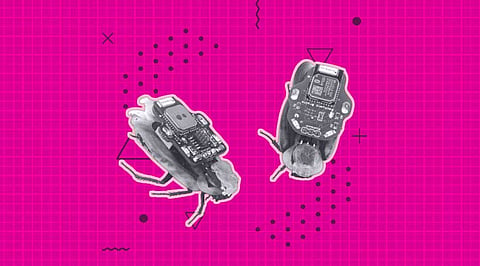

A team of scientists engineered in Singapore, a system for creating remote-controlled cyborg technology cockroaches equipped with a tiny wireless control module. A cockroach fitted with a "backpack" computer and infrared camera, controlled by electrodes, could help locate warm bodies in the rubble of buildings destroyed by earthquakes. The ultra-thin electronics and flexible materials allow the "cockroaches" to move freely. This project turns the conventional approach to insect-like drones on its head.
Hirotaka Sato at Nanyang Technological University in Singapore and his colleagues fitted Madagascar hissing cockroaches with tiny computers connected to electrodes implanted in sensory organs known as cerci on the left and right side of each insect. Madagascar-hissing cockroaches are widely used for cyborg technology insect research. This is one of the world's largest cockroaches, reaching up to 3 inches in length, the team selected this species for its high payload capacity during flight.
Researchers have been exploring ways to tether live insects to miniaturized computer hardware so they can manipulate an insect's movement. The researchers spent years studying how to remote-control the movements of the cockroach by using electrodes to stimulate different neuromuscular sites, including those that activate flight. They also included an ambient temperature sensor and a tiny Bluetooth transmitter and receiver. Though there is already technology present to control cockroaches, the microcircuit developed here offers a greater degree of freedom in movement than in conventionally designed ones.
The method uses power from a rechargeable battery attached to a solar cell. Cockroaches have two antennae on their anterior end. These antennae assist to guide cockroaches through the world by sensing touch and smell. The ultrathin electronics and flexible materials allow the 'cockroaches' to move freely. These tiny "hair-like" sensors are connected directly to neurons that communicate messages to the cockroach brain. The body-mounted organic solar cell module achieves a power output of 17.2 mW.
The microcircuit incorporates a 9-axis inertial measurement unit that can detect the roach's six degrees of free motion, its linear and rotational acceleration, and its compass heading. The microcircuit was designed by the research team in a trial-and-error method. The microcircuit developed is a small but a certain step toward bio-robots that are not only insect-driven but fall under the broad umbrella of human cybernetic integration. Future real-world applications for cyborg technology roaches would need the critters to crawl where humans couldn't watch from overhead.
The backpack also contains a small infrared camera that detects heat signatures from humans, sensors that identify body movement and carbon dioxide, and a chip that wirelessly transmits data back to the rescue team. The researchers had to find the optimum voltage, frequency, and cycle needed for the stimuli to respond. The tests showed the cockroach moving left when its right antenna lobe was stimulated and moving right when the left one received a small electrical charge. Toward that end, the research team wants to outfit the control backpacks with sensors like GPS, compass, and accelerometer.
Join our WhatsApp Channel to get the latest news, exclusives and videos on WhatsApp
_____________
Disclaimer: Analytics Insight does not provide financial advice or guidance. Also note that the cryptocurrencies mentioned/listed on the website could potentially be scams, i.e. designed to induce you to invest financial resources that may be lost forever and not be recoverable once investments are made. You are responsible for conducting your own research (DYOR) before making any investments. Read more here.
